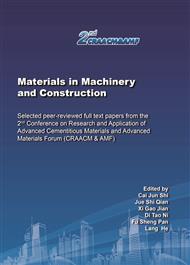[1]
A.Ikesue, Y.L. Aung, High quality sapphire crystal by advanced chemical transport process. J. Eur. Ceram. Soc. 40(2020)4536-4538.
DOI: 10.1016/j.jeurceramsoc.2020.05.069
Google Scholar
[2]
V.N. Kurlov, Sapphire: properties, growth, and applications, Reference Module in Materials Science and Materials Engineering, (2016), https://doi.org/10.1016/B978-0-12-803561-8.03681-x.
DOI: 10.1016/b978-0-12-803581-8.03681-x
Google Scholar
[3]
L.Z. Yao. Fundamentals of crystal growth,University of science and Technology of China Press, Hefei: China ,(1995).
Google Scholar
[4]
Y.R. Li, W.J. Zhang, S.C. Wang,Two-dimensional numerical simulation of thermocapillary convection in annular two-layer system, J. Microgravity Sci. Technol.20 (2008) 313-317.
DOI: 10.1007/s12217-008-9020-9
Google Scholar
[5]
Y.R. Li, W.J. Zhang, P. Lan. Thermal convection in an annular two-layer system under combined action of buoyancy and thermocapillary forces , J. Supercond. Nov. Magn. 23(2010) 1219-1223.
DOI: 10.1007/s10948-010-0681-4
Google Scholar
[6]
Y.R. Li, S.C. Wang, S.Y.Wu, et al, Asymptotic solution of thermocapillary convection in thin annular two-layer system with upper free surface, Int. J.Heat Mass Transf., 52(2009) 4769-4777.
DOI: 10.1016/j.ijheatmasstransfer.2009.06.010
Google Scholar
[7]
Y.R. Li,S.C. Wang, S.Y.Wu. Asymptotic solution of thermocapillary convection in two immiscible liquid layers in a shallow annular cavity, Sci. China Technol. Sci. , 53(2010) (6) 1655-1665.
DOI: 10.1007/s11431-010-3166-6
Google Scholar
[8]
I.Simanovskii, A.Nepomnyshchy, A. Viviani, et al., Nonlinear waves in two-layer systems with a temperature-depent interfacial heat release, Microgravity Sci.Technol. 28(2016) (4) 381-393.
DOI: 10.1007/s12217-016-9491-z
Google Scholar
[9]
I.Simanovskii, A. Viviani, F. Dubois, Convective flows in a two-layer system with an interfacial heat release under the action of an imposed temperature gradient, Int. J.Therm Sci., 113(2017) 51-64.
DOI: 10.1016/j.ijthermalsci.2016.11.015
Google Scholar
[10]
I.Simanovskii, A. Viviani, F. Dubois, et al., Nonlinear convective flows in a laterally heated two-layer system with a temperature-dependent heat release/consumption at the interface, Microgravity Sci.Technol. 30(2018)243-256.
DOI: 10.1007/s12217-018-9593-x
Google Scholar
[11]
A.Nepomnyashchy, I.Simanovskii, A. Viviani, et al., Multistability in multilayer systems, Microgravity Sci. Technol.,31,(2019) 557–568.
DOI: 10.1007/s12217-019-09711-z
Google Scholar
[12]
A.Nepomnyashchy, I. Simanovskii, The influence of two-dimensional temperature modulation on nonlinear Marangoni waves in two-layer films, J.Fluid Mech.846(2018)944-965.
DOI: 10.1017/jfm.2018.304
Google Scholar
[13]
V. B. Bekezhanova, O. N. Goncharova, Analysis of characteristics of two-layer convective flows with diffusive type evaporation based on exact solutions, Microgravity Sci. Technol.,32(2019)139-154.
DOI: 10.1007/s12217-019-09764-0
Google Scholar
[14]
V. B. Bekezhanova, O. N. Goncharova, Impact of gravity on the flow pattern in a locally heated two-layer system, Microgravity Sci. Technol.,32(2020)229-243.
DOI: 10.1007/s12217-019-09777-9
Google Scholar
[15]
D.M.Mo, Y.R.Li, W.Y. Shi. Linear-stability analysis of thermocapillary flow in an annular two-layer system with upper rigid wall, Microgravity Sci.Technol. 23 (S1)(2011) 43–48.
DOI: 10.1007/s12217-011-9269-2
Google Scholar
[16]
D.M.Mo,D.F. Ruan. Linear-stability analysis of thermocapillary convection in an annular two-layer system with free surface subjected to a radial temperature gradient. J. Mech. Sci. Technol., 2018, 32 (7) 3437–3444.
DOI: 10.1007/s12206-018-0647-1
Google Scholar
[17]
D.M.Mo, D.F. Ruan. Linear-stability analysis of thermocapillary-buoyancy convection in an annular two-layer system with upper rigid wall subjected to a radial temperature gradient, Microgravity Sci.Technol. 31(3)(2019) 293-304.
DOI: 10.1007/s12217-019-9692-3
Google Scholar
[18]
H.S. Fang, J.Tian, Q.J. Zhang, et al.,Study of melt convection and interface shape during sapphire crystal growth by Czochralski method, Int. J.Heat Mass Transf., 55(2012) 8003-8009.
DOI: 10.1016/j.ijheatmasstransfer.2012.08.029
Google Scholar
[19]
N.Zhang, H.G. Park, J.J. Derby, Simulation of heat transfer and convection during sapphire crystal growth in a modified heat exchanger method, J. Cryst. Growth, 367(2013) 27-34.
DOI: 10.1016/j.jcrysgro.2013.01.011
Google Scholar
[20]
Y.R. He, Z.W. Hua, M.J. Chen, et al. Numerical simulation of the sapphire growth process using a self-regulating thermal boundary condition method, Appl. Therm. Eng., 132(2018) 87-94.
DOI: 10.1016/j.applthermaleng.2017.12.065
Google Scholar
[21]
S.E. Demina, E.N. Bystrova, V.S. Postolov, et al. Use of numerical simulation for growing high-quality sapphire crystals by the Kyropoulos method , J. Cryst. Growth., 310(2008)1443–1447.
DOI: 10.1016/j.jcrysgro.2007.11.083
Google Scholar
[22]
S. Madruga, G.C. Perez, G. Lebon, Convective instabilities in two superposed horizontal liquid layers heated laterally, Phys. Rev. E, 68(2003)041607.
DOI: 10.1103/physreve.68.041607
Google Scholar
[23]
X.Q. Chen, W.Y. Shi, H.M.Li, Linear stability analysis of anomalous thermocapillary convection and stability in annular pools, J.Eng. Thermophysics,38(6)(2017)1274-1281.
Google Scholar
[24]
M.W. Chen, Investigation on anomalous thermocapillary convection and instability in rotating annular pools, Master's degree thesis of Chongqing University, (2019).
Google Scholar
[25]
W.Y. Shi, Y.R.Li, L.Peng, Effect of Prandtl number on thermocapillary convection in shallow annular pools, J.Eng. Thermophysics, 32(2011)250-254.
Google Scholar
[26]
D.M.Mo, Influence of liquid layer depth ratio on stability of thermocapillary flow in annular two-layer system with upper rigid wall, J.Ther.Sci.Tech., 14(2015)214-220.
Google Scholar
[27]
Q.S. Liu, B.Roux, W.R.Hu, Study on convection of multiple liquid layers, Adv.Mech., 27(4) (1997)518-535.
Google Scholar


